Change Management Case Study: Starbucks' Racial Incident and Response
VerifiedAdded on 2022/11/15
|6
|1769
|1
Case Study
AI Summary
This case study analysis examines the Starbucks incidents in Philadelphia and Arizona, focusing on the application of various management theories to understand and address issues of racism and intolerance. The paper explores how classical and human relations theories might have contributed to the initial incident, while contingency theory and cultural excellence are used to analyze Starbucks' response, particularly the anti-bias training program. The analysis also discusses the factors that led to the ejection of police officers, and finally, it investigates how Starbucks could have used organizational learning to improve their handling of the situation. The paper covers the application of theories like the classical theory, human relations, contingency theory, and cultural excellence in the context of the Starbucks case, including the impact of the incident on employees and customers, the organizational structure, and the importance of training and shared values. The paper also highlights the importance of adapting to change and the need for long-term growth and employee development.
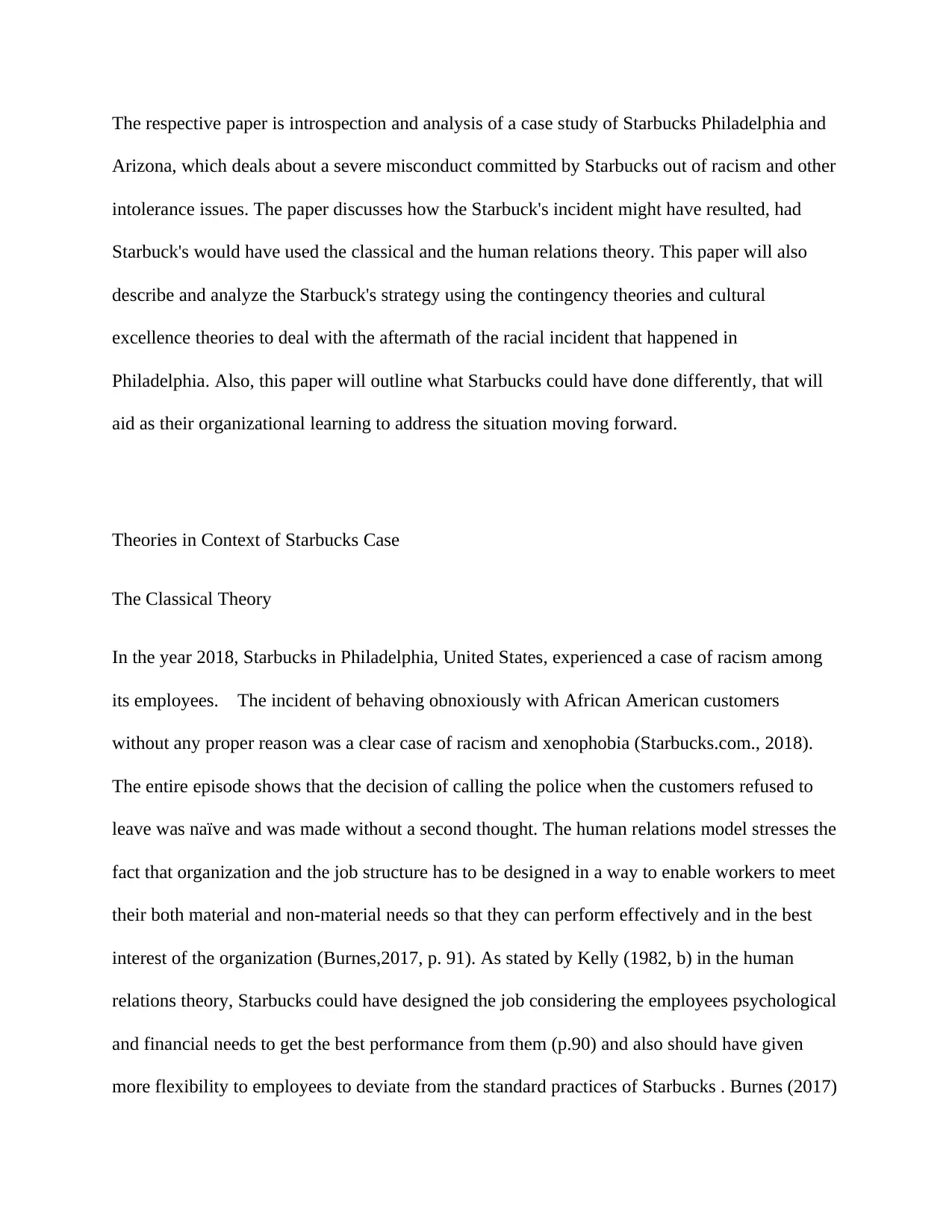
The respective paper is introspection and analysis of a case study of Starbucks Philadelphia and
Arizona, which deals about a severe misconduct committed by Starbucks out of racism and other
intolerance issues. The paper discusses how the Starbuck's incident might have resulted, had
Starbuck's would have used the classical and the human relations theory. This paper will also
describe and analyze the Starbuck's strategy using the contingency theories and cultural
excellence theories to deal with the aftermath of the racial incident that happened in
Philadelphia. Also, this paper will outline what Starbucks could have done differently, that will
aid as their organizational learning to address the situation moving forward.
Theories in Context of Starbucks Case
The Classical Theory
In the year 2018, Starbucks in Philadelphia, United States, experienced a case of racism among
its employees. The incident of behaving obnoxiously with African American customers
without any proper reason was a clear case of racism and xenophobia (Starbucks.com., 2018).
The entire episode shows that the decision of calling the police when the customers refused to
leave was naïve and was made without a second thought. The human relations model stresses the
fact that organization and the job structure has to be designed in a way to enable workers to meet
their both material and non-material needs so that they can perform effectively and in the best
interest of the organization (Burnes,2017, p. 91). As stated by Kelly (1982, b) in the human
relations theory, Starbucks could have designed the job considering the employees psychological
and financial needs to get the best performance from them (p.90) and also should have given
more flexibility to employees to deviate from the standard practices of Starbucks . Burnes (2017)
Arizona, which deals about a severe misconduct committed by Starbucks out of racism and other
intolerance issues. The paper discusses how the Starbuck's incident might have resulted, had
Starbuck's would have used the classical and the human relations theory. This paper will also
describe and analyze the Starbuck's strategy using the contingency theories and cultural
excellence theories to deal with the aftermath of the racial incident that happened in
Philadelphia. Also, this paper will outline what Starbucks could have done differently, that will
aid as their organizational learning to address the situation moving forward.
Theories in Context of Starbucks Case
The Classical Theory
In the year 2018, Starbucks in Philadelphia, United States, experienced a case of racism among
its employees. The incident of behaving obnoxiously with African American customers
without any proper reason was a clear case of racism and xenophobia (Starbucks.com., 2018).
The entire episode shows that the decision of calling the police when the customers refused to
leave was naïve and was made without a second thought. The human relations model stresses the
fact that organization and the job structure has to be designed in a way to enable workers to meet
their both material and non-material needs so that they can perform effectively and in the best
interest of the organization (Burnes,2017, p. 91). As stated by Kelly (1982, b) in the human
relations theory, Starbucks could have designed the job considering the employees psychological
and financial needs to get the best performance from them (p.90) and also should have given
more flexibility to employees to deviate from the standard practices of Starbucks . Burnes (2017)
Secure Best Marks with AI Grader
Need help grading? Try our AI Grader for instant feedback on your assignments.
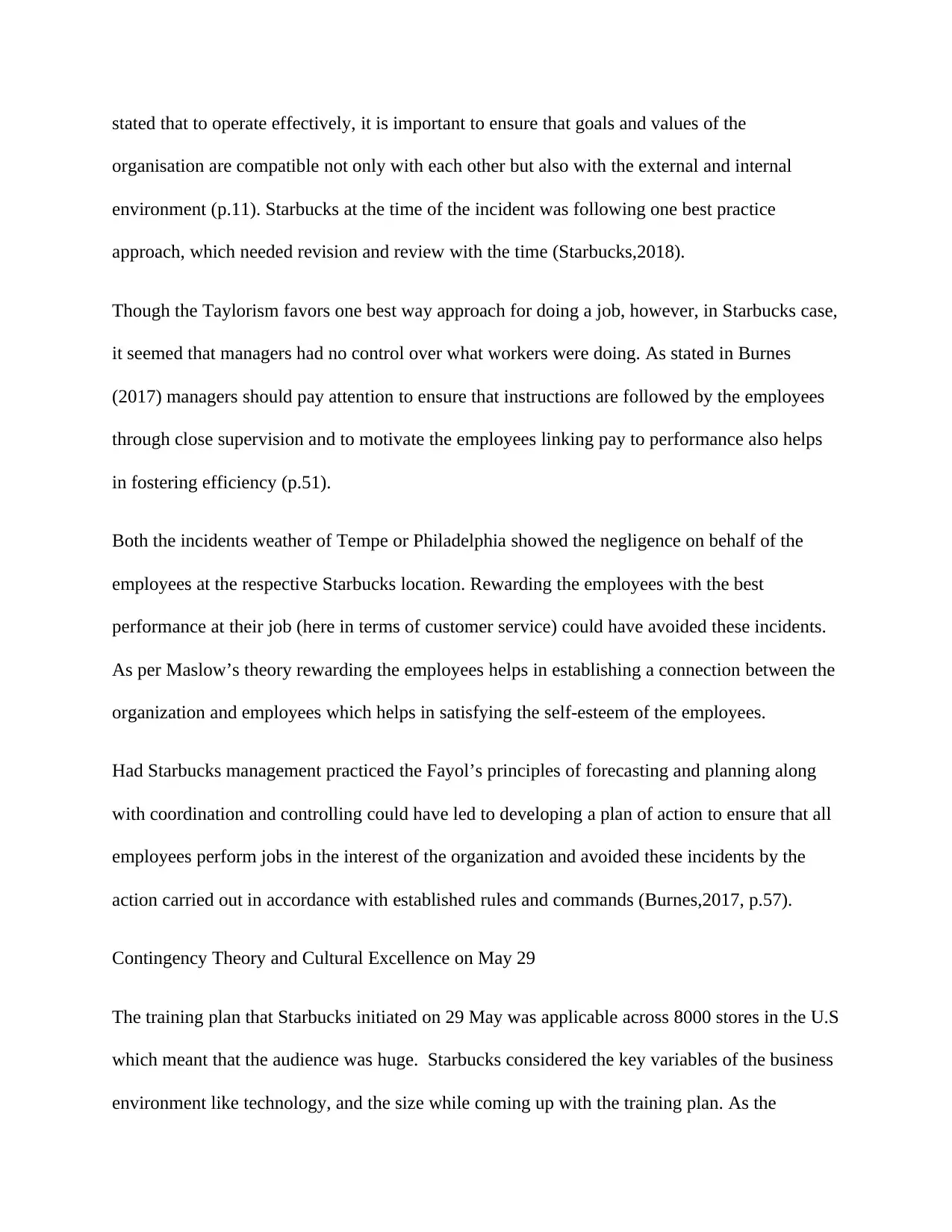
stated that to operate effectively, it is important to ensure that goals and values of the
organisation are compatible not only with each other but also with the external and internal
environment (p.11). Starbucks at the time of the incident was following one best practice
approach, which needed revision and review with the time (Starbucks,2018).
Though the Taylorism favors one best way approach for doing a job, however, in Starbucks case,
it seemed that managers had no control over what workers were doing. As stated in Burnes
(2017) managers should pay attention to ensure that instructions are followed by the employees
through close supervision and to motivate the employees linking pay to performance also helps
in fostering efficiency (p.51).
Both the incidents weather of Tempe or Philadelphia showed the negligence on behalf of the
employees at the respective Starbucks location. Rewarding the employees with the best
performance at their job (here in terms of customer service) could have avoided these incidents.
As per Maslow’s theory rewarding the employees helps in establishing a connection between the
organization and employees which helps in satisfying the self-esteem of the employees.
Had Starbucks management practiced the Fayol’s principles of forecasting and planning along
with coordination and controlling could have led to developing a plan of action to ensure that all
employees perform jobs in the interest of the organization and avoided these incidents by the
action carried out in accordance with established rules and commands (Burnes,2017, p.57).
Contingency Theory and Cultural Excellence on May 29
The training plan that Starbucks initiated on 29 May was applicable across 8000 stores in the U.S
which meant that the audience was huge. Starbucks considered the key variables of the business
environment like technology, and the size while coming up with the training plan. As the
organisation are compatible not only with each other but also with the external and internal
environment (p.11). Starbucks at the time of the incident was following one best practice
approach, which needed revision and review with the time (Starbucks,2018).
Though the Taylorism favors one best way approach for doing a job, however, in Starbucks case,
it seemed that managers had no control over what workers were doing. As stated in Burnes
(2017) managers should pay attention to ensure that instructions are followed by the employees
through close supervision and to motivate the employees linking pay to performance also helps
in fostering efficiency (p.51).
Both the incidents weather of Tempe or Philadelphia showed the negligence on behalf of the
employees at the respective Starbucks location. Rewarding the employees with the best
performance at their job (here in terms of customer service) could have avoided these incidents.
As per Maslow’s theory rewarding the employees helps in establishing a connection between the
organization and employees which helps in satisfying the self-esteem of the employees.
Had Starbucks management practiced the Fayol’s principles of forecasting and planning along
with coordination and controlling could have led to developing a plan of action to ensure that all
employees perform jobs in the interest of the organization and avoided these incidents by the
action carried out in accordance with established rules and commands (Burnes,2017, p.57).
Contingency Theory and Cultural Excellence on May 29
The training plan that Starbucks initiated on 29 May was applicable across 8000 stores in the U.S
which meant that the audience was huge. Starbucks considered the key variables of the business
environment like technology, and the size while coming up with the training plan. As the
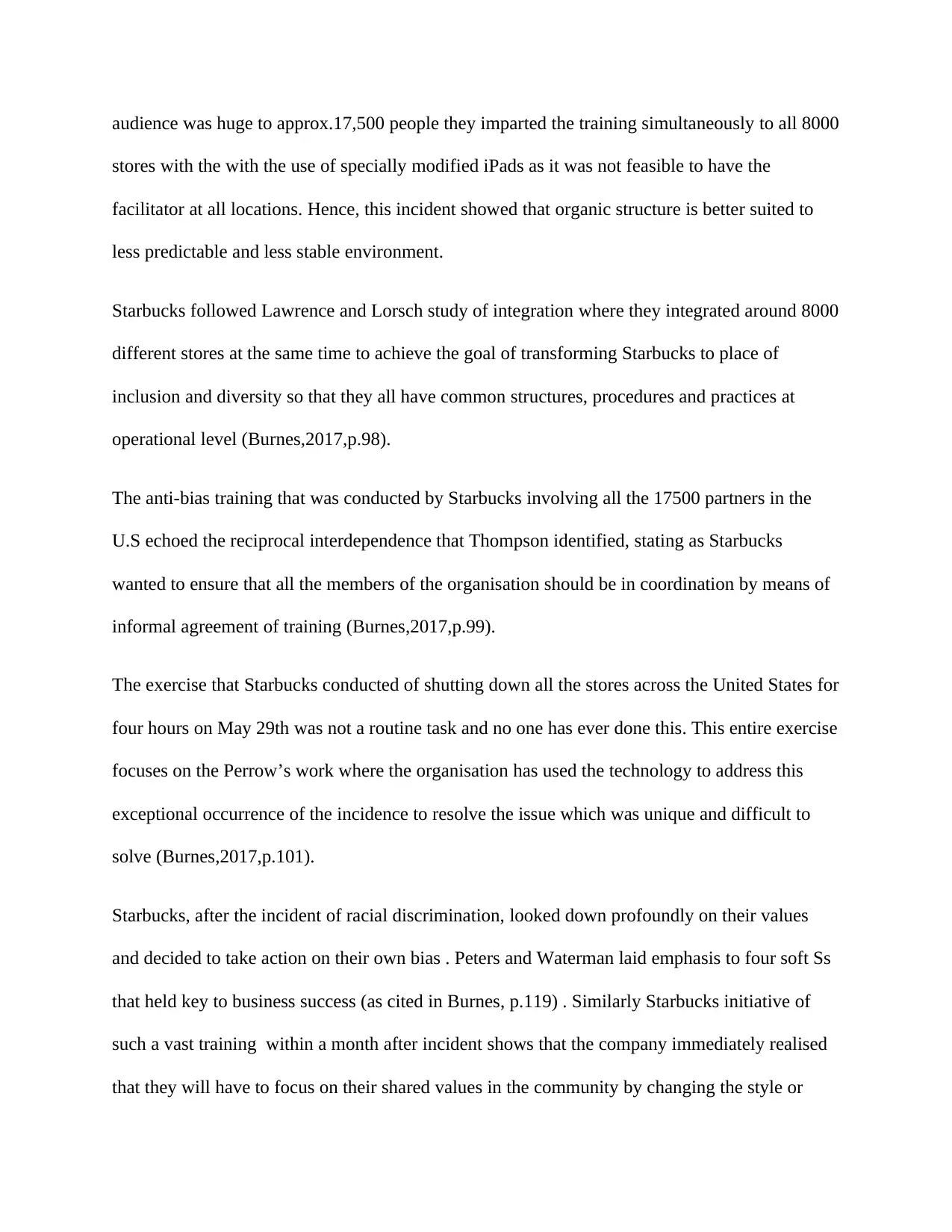
audience was huge to approx.17,500 people they imparted the training simultaneously to all 8000
stores with the with the use of specially modified iPads as it was not feasible to have the
facilitator at all locations. Hence, this incident showed that organic structure is better suited to
less predictable and less stable environment.
Starbucks followed Lawrence and Lorsch study of integration where they integrated around 8000
different stores at the same time to achieve the goal of transforming Starbucks to place of
inclusion and diversity so that they all have common structures, procedures and practices at
operational level (Burnes,2017,p.98).
The anti-bias training that was conducted by Starbucks involving all the 17500 partners in the
U.S echoed the reciprocal interdependence that Thompson identified, stating as Starbucks
wanted to ensure that all the members of the organisation should be in coordination by means of
informal agreement of training (Burnes,2017,p.99).
The exercise that Starbucks conducted of shutting down all the stores across the United States for
four hours on May 29th was not a routine task and no one has ever done this. This entire exercise
focuses on the Perrow’s work where the organisation has used the technology to address this
exceptional occurrence of the incidence to resolve the issue which was unique and difficult to
solve (Burnes,2017,p.101).
Starbucks, after the incident of racial discrimination, looked down profoundly on their values
and decided to take action on their own bias . Peters and Waterman laid emphasis to four soft Ss
that held key to business success (as cited in Burnes, p.119) . Similarly Starbucks initiative of
such a vast training within a month after incident shows that the company immediately realised
that they will have to focus on their shared values in the community by changing the style or
stores with the with the use of specially modified iPads as it was not feasible to have the
facilitator at all locations. Hence, this incident showed that organic structure is better suited to
less predictable and less stable environment.
Starbucks followed Lawrence and Lorsch study of integration where they integrated around 8000
different stores at the same time to achieve the goal of transforming Starbucks to place of
inclusion and diversity so that they all have common structures, procedures and practices at
operational level (Burnes,2017,p.98).
The anti-bias training that was conducted by Starbucks involving all the 17500 partners in the
U.S echoed the reciprocal interdependence that Thompson identified, stating as Starbucks
wanted to ensure that all the members of the organisation should be in coordination by means of
informal agreement of training (Burnes,2017,p.99).
The exercise that Starbucks conducted of shutting down all the stores across the United States for
four hours on May 29th was not a routine task and no one has ever done this. This entire exercise
focuses on the Perrow’s work where the organisation has used the technology to address this
exceptional occurrence of the incidence to resolve the issue which was unique and difficult to
solve (Burnes,2017,p.101).
Starbucks, after the incident of racial discrimination, looked down profoundly on their values
and decided to take action on their own bias . Peters and Waterman laid emphasis to four soft Ss
that held key to business success (as cited in Burnes, p.119) . Similarly Starbucks initiative of
such a vast training within a month after incident shows that the company immediately realised
that they will have to focus on their shared values in the community by changing the style or

behaviour to handle their operations . Starbucks focused on its strategy and planned the action to
impart the anti-bias training to connect to the customers closely. The anti-bias training has
helped Starbucks employees to enhance the skills.
Starbucks followed the Kanter 's strategy to restructure the company as a whole to find the
synergy to make their operations efficient (Burnes,2017, p.127) . Training at such a vast level by
Starbucks was an attempt to identify and concentrate on the core business area of customer
service. The company attempted to remove obstacles from their way by conducting anti-bias
training at such a vast level within a month of the incidence showed Starbucks responsiveness as
an organisation. Kanter identified the opening boundaries to form the strategic alliances,
similarly Starbucks had also partnered with various training leaders like SY partners , Black
Partner Network and other representatives to form the strategic alliances to bring the change in
itself .
Starbucks initiative of conducting such a large training at the national scale was something that
never happened before . Starbuck's strategized to use Handy's generic organisations of triple I of
generating the ideas by conducting the training across the 8000 stores to ensure transitional
perspectives of racial discrimination are being transferred to anti-discrimination and will
generate the added value to ensure success in the future ( Burnes,2017.p.137).
The incident on July 4th where Starbucks again witnessed an example of hate and intolerance
within its campus when it happened that six police offers, who were having recreational time in
Starbucks in Arizona were asked to leave as their presence intimidated a nearby customer. The
organization provided the employees with training in the field of cultural excellence to excel in
global environment as the employees of the company lacked in public relations. The Cultural
impart the anti-bias training to connect to the customers closely. The anti-bias training has
helped Starbucks employees to enhance the skills.
Starbucks followed the Kanter 's strategy to restructure the company as a whole to find the
synergy to make their operations efficient (Burnes,2017, p.127) . Training at such a vast level by
Starbucks was an attempt to identify and concentrate on the core business area of customer
service. The company attempted to remove obstacles from their way by conducting anti-bias
training at such a vast level within a month of the incidence showed Starbucks responsiveness as
an organisation. Kanter identified the opening boundaries to form the strategic alliances,
similarly Starbucks had also partnered with various training leaders like SY partners , Black
Partner Network and other representatives to form the strategic alliances to bring the change in
itself .
Starbucks initiative of conducting such a large training at the national scale was something that
never happened before . Starbuck's strategized to use Handy's generic organisations of triple I of
generating the ideas by conducting the training across the 8000 stores to ensure transitional
perspectives of racial discrimination are being transferred to anti-discrimination and will
generate the added value to ensure success in the future ( Burnes,2017.p.137).
The incident on July 4th where Starbucks again witnessed an example of hate and intolerance
within its campus when it happened that six police offers, who were having recreational time in
Starbucks in Arizona were asked to leave as their presence intimidated a nearby customer. The
organization provided the employees with training in the field of cultural excellence to excel in
global environment as the employees of the company lacked in public relations. The Cultural
Secure Best Marks with AI Grader
Need help grading? Try our AI Grader for instant feedback on your assignments.
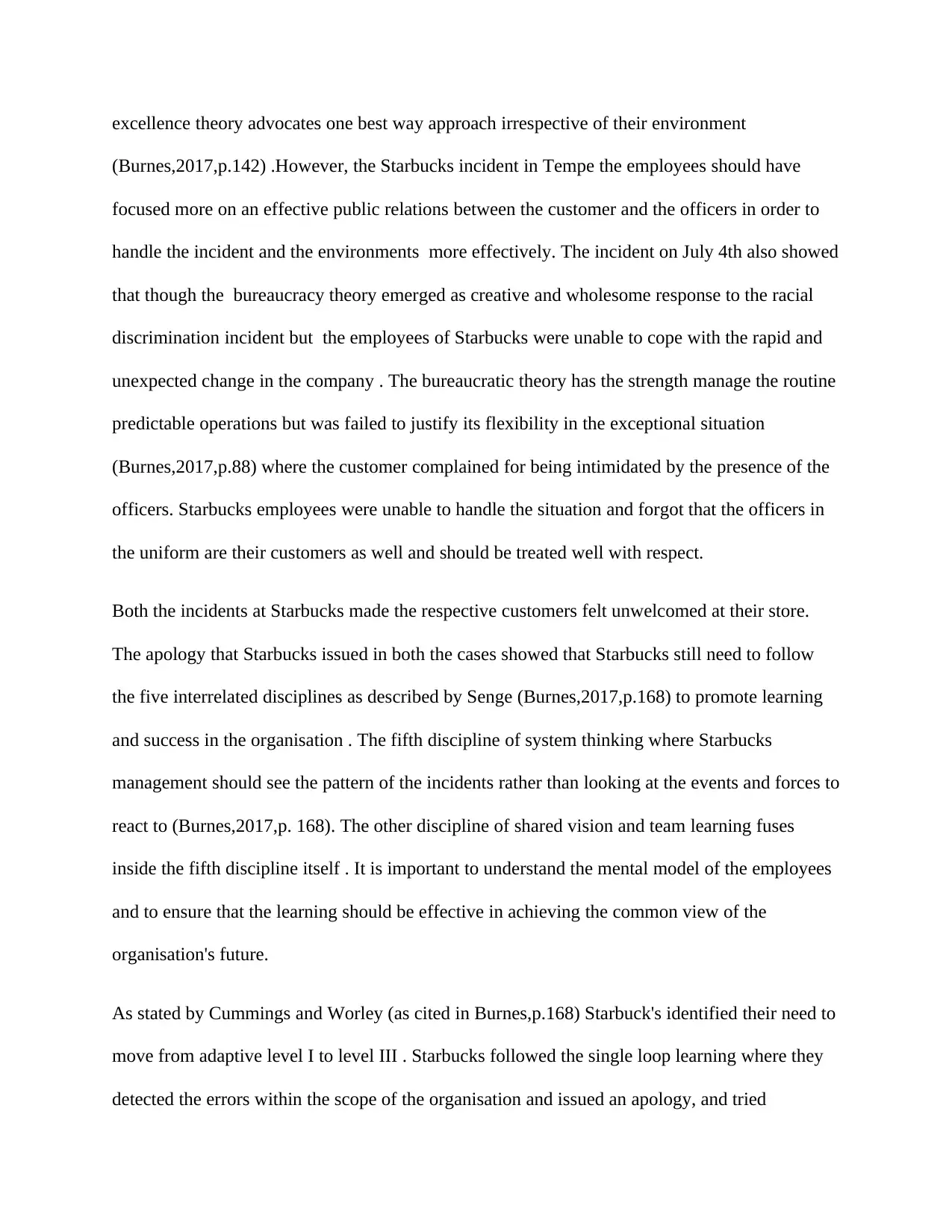
excellence theory advocates one best way approach irrespective of their environment
(Burnes,2017,p.142) .However, the Starbucks incident in Tempe the employees should have
focused more on an effective public relations between the customer and the officers in order to
handle the incident and the environments more effectively. The incident on July 4th also showed
that though the bureaucracy theory emerged as creative and wholesome response to the racial
discrimination incident but the employees of Starbucks were unable to cope with the rapid and
unexpected change in the company . The bureaucratic theory has the strength manage the routine
predictable operations but was failed to justify its flexibility in the exceptional situation
(Burnes,2017,p.88) where the customer complained for being intimidated by the presence of the
officers. Starbucks employees were unable to handle the situation and forgot that the officers in
the uniform are their customers as well and should be treated well with respect.
Both the incidents at Starbucks made the respective customers felt unwelcomed at their store.
The apology that Starbucks issued in both the cases showed that Starbucks still need to follow
the five interrelated disciplines as described by Senge (Burnes,2017,p.168) to promote learning
and success in the organisation . The fifth discipline of system thinking where Starbucks
management should see the pattern of the incidents rather than looking at the events and forces to
react to (Burnes,2017,p. 168). The other discipline of shared vision and team learning fuses
inside the fifth discipline itself . It is important to understand the mental model of the employees
and to ensure that the learning should be effective in achieving the common view of the
organisation's future.
As stated by Cummings and Worley (as cited in Burnes,p.168) Starbuck's identified their need to
move from adaptive level I to level III . Starbucks followed the single loop learning where they
detected the errors within the scope of the organisation and issued an apology, and tried
(Burnes,2017,p.142) .However, the Starbucks incident in Tempe the employees should have
focused more on an effective public relations between the customer and the officers in order to
handle the incident and the environments more effectively. The incident on July 4th also showed
that though the bureaucracy theory emerged as creative and wholesome response to the racial
discrimination incident but the employees of Starbucks were unable to cope with the rapid and
unexpected change in the company . The bureaucratic theory has the strength manage the routine
predictable operations but was failed to justify its flexibility in the exceptional situation
(Burnes,2017,p.88) where the customer complained for being intimidated by the presence of the
officers. Starbucks employees were unable to handle the situation and forgot that the officers in
the uniform are their customers as well and should be treated well with respect.
Both the incidents at Starbucks made the respective customers felt unwelcomed at their store.
The apology that Starbucks issued in both the cases showed that Starbucks still need to follow
the five interrelated disciplines as described by Senge (Burnes,2017,p.168) to promote learning
and success in the organisation . The fifth discipline of system thinking where Starbucks
management should see the pattern of the incidents rather than looking at the events and forces to
react to (Burnes,2017,p. 168). The other discipline of shared vision and team learning fuses
inside the fifth discipline itself . It is important to understand the mental model of the employees
and to ensure that the learning should be effective in achieving the common view of the
organisation's future.
As stated by Cummings and Worley (as cited in Burnes,p.168) Starbuck's identified their need to
move from adaptive level I to level III . Starbucks followed the single loop learning where they
detected the errors within the scope of the organisation and issued an apology, and tried
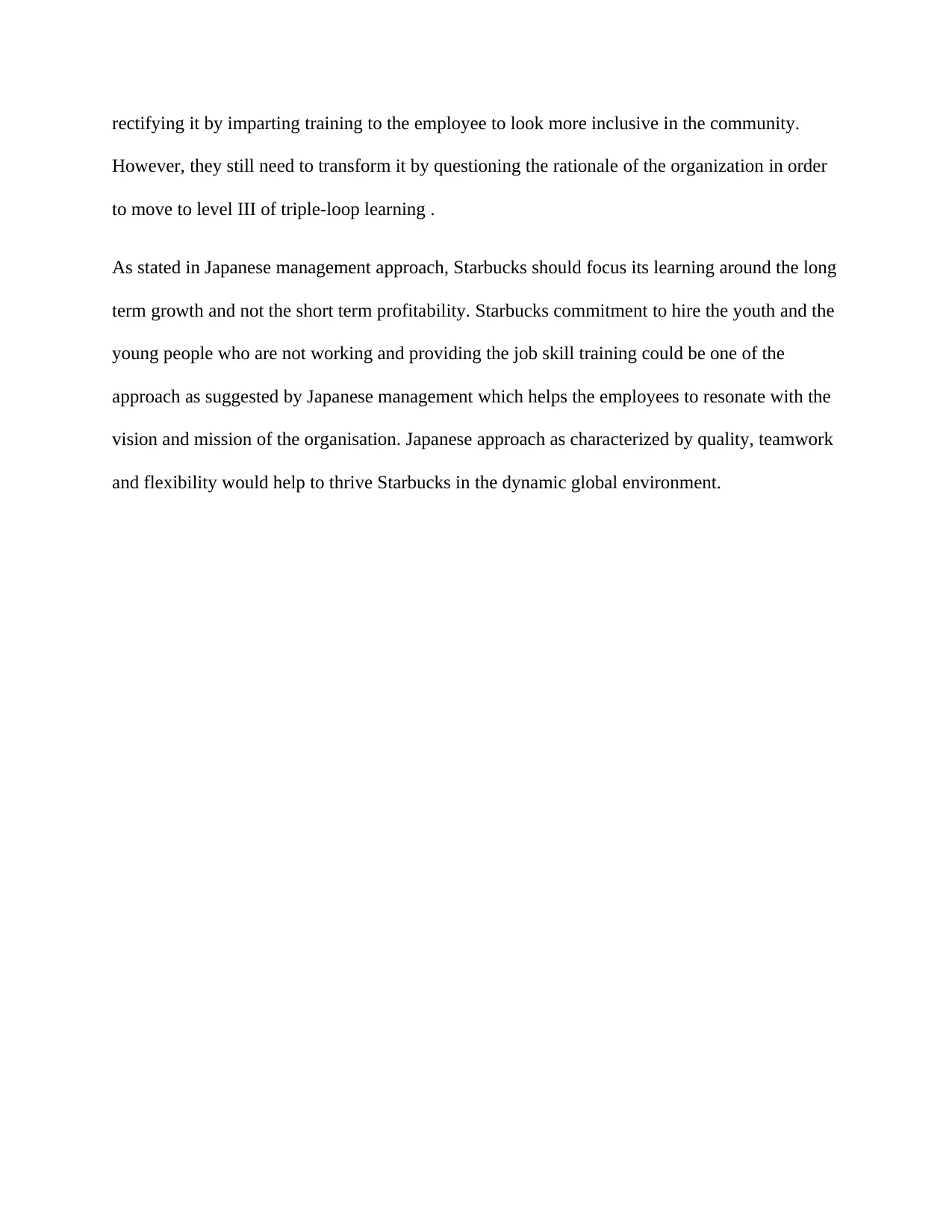
rectifying it by imparting training to the employee to look more inclusive in the community.
However, they still need to transform it by questioning the rationale of the organization in order
to move to level III of triple-loop learning .
As stated in Japanese management approach, Starbucks should focus its learning around the long
term growth and not the short term profitability. Starbucks commitment to hire the youth and the
young people who are not working and providing the job skill training could be one of the
approach as suggested by Japanese management which helps the employees to resonate with the
vision and mission of the organisation. Japanese approach as characterized by quality, teamwork
and flexibility would help to thrive Starbucks in the dynamic global environment.
However, they still need to transform it by questioning the rationale of the organization in order
to move to level III of triple-loop learning .
As stated in Japanese management approach, Starbucks should focus its learning around the long
term growth and not the short term profitability. Starbucks commitment to hire the youth and the
young people who are not working and providing the job skill training could be one of the
approach as suggested by Japanese management which helps the employees to resonate with the
vision and mission of the organisation. Japanese approach as characterized by quality, teamwork
and flexibility would help to thrive Starbucks in the dynamic global environment.
1 out of 6
Related Documents
Your All-in-One AI-Powered Toolkit for Academic Success.
+13062052269
info@desklib.com
Available 24*7 on WhatsApp / Email
![[object Object]](/_next/static/media/star-bottom.7253800d.svg)
Unlock your academic potential
© 2024 | Zucol Services PVT LTD | All rights reserved.





